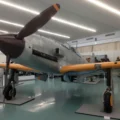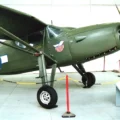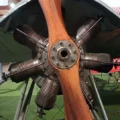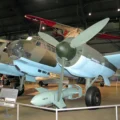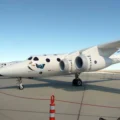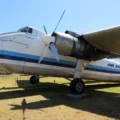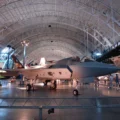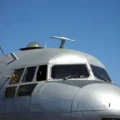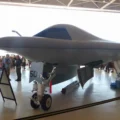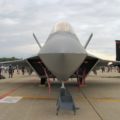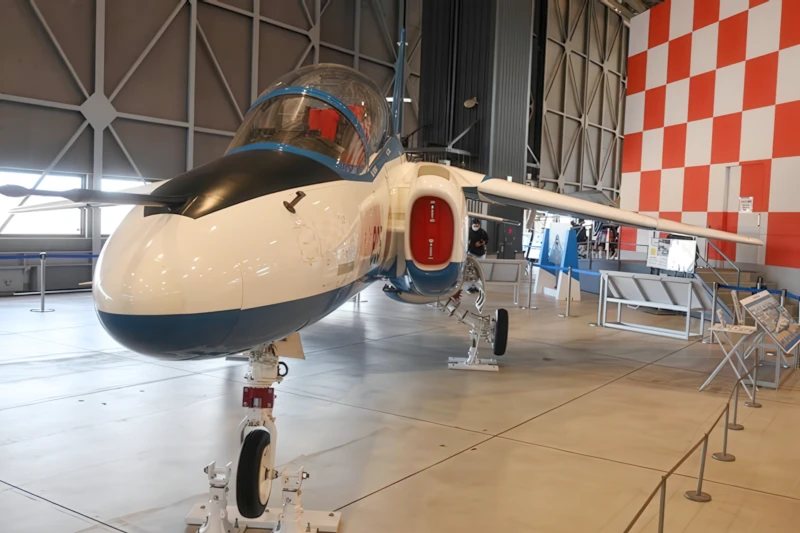
Kawasaki T-4 |
|
|---|---|
| Land | Japan |
| Rolle | Intermediate trainer aircraft |
| Første flyvning | 29 July 1985 |
| Antal bygget | 208+ |
Den Kawasaki T-4 is a Japanese subsonic intermediate jet trainer aircraft developed and manufactured by the commercial conglomerate Kawasaki Heavy Industries. Its sole operator is the Japan Air Self-Defense Force (JASDF), in part due to historic restrictions on the exporting of military hardware. In addition to its primary training mission, the T-4 has been used by the JASDF’s Blue Impulse aerobatic team as well as liaison duties with most fighter units. The first XT-4 prototype flew on 29 July 1985, while the first production aircraft was delivered during September 198
Kilde: Kawasaki T-4 on Wiki
| Kawasaki T-4 Walk Around | |
|---|---|
| Fotograf | Meindert de Vreeze |
| Lokalisering | Unknow |
| Billeder | 39 |
Wait, Searching Kawasaki T-4 for you…

Se også:
Description of the Kawasaki T-4 Aircraft
Executive Summary
The Kawasaki T-4 stands as a pivotal asset within the Japan Air Self-Defense Force’s (JASDF) pilot training architecture. Developed domestically in the 1980s, this intermediate jet trainer was conceived with a strong emphasis on high subsonic maneuverability, operational reliability, and cost-effectiveness. Its sophisticated aerodynamic features, including a transonic airfoil and the strategic incorporation of composite materials, were designed to provide a seamless transition for pilots progressing from elementary propeller aircraft to more advanced fighter platforms. Beyond its fundamental training role, the T-4 has achieved global recognition as the chosen aircraft for Japan’s prestigious Blue Impulse aerobatic team, a testament to its exceptional agility and precise handling characteristics. With a fleet exceeding 200 units delivered between 1988 and 2003, the T-4 has served the JASDF for over three decades. However, its production line has now ceased operations, and the aging aircraft are progressively approaching their retirement age. A significant operational challenge has emerged with the JASDF’s integration of fifth-generation F-35 fighters. The T-4’s subsonic performance envelope and its cockpit technology are no longer considered adequate to fully prepare pilots for the complexities and advanced systems inherent in these modern combat aircraft. Consequently, Japan is actively pursuing a replacement, exploring various avenues including a formal Request for Information (RFI), potential joint development initiatives with the United States, and evaluating leading international and domestic candidates such as the Boeing T-7A Red Hawk, Leonardo M-346 Block 20, and a new Mitsubishi Heavy Industries (MHI) T-X concept. While the T-4’s enduring legacy as a foundational training asset remains undeniable, its operational future is firmly directed towards a comprehensive modernization effort.1. Introduction to the Kawasaki T-4
The Kawasaki T-4 occupies a critical position within Japan’s defense aerospace capabilities, serving as the Japan Air Self-Defense Force’s (JASDF) primary intermediate jet trainer. Its development represented a crucial stride in bolstering Japan’s self-reliant capacity for the production of advanced military aircraft and the comprehensive training of its pilots. Introduced into service in 1988, the T-4 was specifically engineered to bridge the training gap between initial flight instruction, typically conducted on propeller-driven aircraft such as the T-7, and the more demanding requirements of advanced fighter pilot training for platforms like the F-15J and F-2. The aircraft’s inherent agility and responsive controls also rendered it the ideal choice for the renowned Blue Impulse aerobatic team, significantly elevating its public recognition and demonstrating its exceptional flight envelope.2. Development History and Design Philosophy
Origins and Succession
The T-4 Intermediate Trainer was developed by the Japanese aerospace industry as the designated successor to the Japan Air Self-Defense Force’s Lockheed T-33 Jet Trainer. This initiative aimed to modernize the training fleet with capabilities more aligned with contemporary and future fighter aircraft.Program Initiation and Leadership
Kawasaki Heavy Industries was formally appointed as the prime contractor for the MTX (middle training aircraft) program on September 4, 1981. The aircraft’s design, which was based on Kawasaki’s KA-851 concept, was spearheaded by the distinguished aeronautical engineer Kohki Isozaki. Basic design studies were finalized by October 1982, leading to the approval of funding in fiscal years 1983 and 1984 for the construction of four flying prototypes. Prototype construction commenced in April 1984, culminating in the maiden flight of the XT-4 in 1985.Core Design Objectives
The T-4’s design philosophy was meticulously defined to fulfill the specific training requirements of the JASDF, with a strong emphasis on several key attributes:- High Subsonic Maneuverability: A primary objective was to ensure effective pilot training across diverse flight regimes and to facilitate the execution of complex aerobatic sequences.
- Reliability and Low Operating Cost: These factors were paramount for a trainer aircraft, which is expected to accumulate extensive flight hours throughout its operational lifespan.
- Enhanced Safety (Twin-Engine Configuration): The strategic decision to adopt a twin-engine layout was driven primarily by a high priority placed on safety, rather than solely for increased power. This was a critical consideration for a platform dedicated to pilot training.
- Transonic Aerodynamic Performance: The aircraft was required to demonstrate proficiency within the transonic speed range, a capability vital for preparing pilots for the unique aerodynamic characteristics of supersonic combat jets. This was successfully achieved through the innovative adoption of a transonic airfoil.
- Robust, Damage-Tolerant, and Long-Lived Structure: The airframe was specified for an impressive total lifespan of 7,500 flight hours, necessitating a durable and resilient construction.
Technological Advancements in Design and Manufacturing
The development of the T-4 incorporated several advanced technological features for its era:- Transonic Airfoil: This advanced airfoil was jointly developed by Kawasaki and Japan’s Technical Research and Development Institute (TRDI). It provided exceptional flying qualities, agility, superior high-angle-of-attack handling, and favorable spin characteristics. This design feature was instrumental in enabling elementary-level trainees to smoothly transition to advanced-level fighter training courses.
- Composite Material Usage: The strategic and limited application of Carbon Fiber Reinforced Plastic (CFRP) and Aramid Fiber Reinforced Plastic (AFRP) in components such as the vertical tail, ailerons, rudders, fin, airbrakes, and tailplane trailing-edges significantly contributed to weight reduction and enhanced structural integrity. The primary structural material remained aluminum alloy, with titanium utilized sparingly in critical, high-stress areas.
- Computer-Aided Design (CAD) and Manufacturing (CAM): The extensive application of these digital techniques played a crucial role in achieving the design’s certification for its demanding 7,500 flight-hour lifespan.
Collaborative Manufacturing Contributions
The T-4’s production was a collaborative effort among key Japanese aerospace manufacturers:- Kawasaki: Held responsibility for the forward fuselage, final assembly, and comprehensive flight testing.
- Fuji: Manufactured the rear fuselage, wings, and tail unit.
- Mitsubishi: Produced the center-fuselage and the engine air intakes.
Flight Testing and Refinements
The four XT-4 prototypes underwent an intensive two-and-a-half-year flight test program, accumulating approximately 500 individual flights. Feedback from this phase led to only minor refinements, primarily involving improvements to the braking system and subtle adjustments to the hydraulically actuated flight control system, underscoring the robustness of the initial design.3. General Characteristics and Technical Specifications
Overall Design
The Kawasaki T-4 is characterized by its high subsonic maneuverability and its inherent capability to carry external loads under its wings and fuselage. Its distinctive airframe features anhedral mid-mounted wings with extended chord outer panels, which incorporate dog-tooth leading-edges. The aircraft is designed with tandem stepped cockpits equipped with dual controls, and notably includes a baggage compartment in the center-fuselage, catering to its secondary liaison role.Dimensions
The physical dimensions and weight of the Kawasaki T-4 are detailed in Table 3.1. Table 3.1: Kawasaki T-4 Key Dimensions and Weights| Characteristic | Værdi | Unit |
| Wing Span | 9.94 | M |
| Længde | 13.0 | M |
| Højde | 4.6 | M |
| MTOW | 7.5 | T |
Engine Specifications
The T-4 is powered by two Ishikawajima-Harima F3-IHI-30 turbofan engines. Each engine provides 16.37 kN (3,680 lb st) of thrust. These engines are mounted side-by-side within the center-fuselage and are notable for being domestically produced.Performance Metrics
The operational performance characteristics of the Kawasaki T-4 are summarized in Table 3.2. Table 3.2: Kawasaki T-4 Performance Specifications| Characteristic | Værdi | Unit |
| Maximum Speed | 1,038 (645 mph, 560 kn) / Mach 0.9 | km/t |
| Cruising Range | 1,300 | Km |
| Maximum Range | 1,668 (with drop tanks) | Km |
| Service Ceiling | 15,240 (50,000) | m (ft) |
| Rate of Climb | 51 (10,000) | m/s (ft/min) |
| Take Off Distance | 550 | M |
| Landing Distance | 670 | M |
Fuel Capacity and System
The total internal fuel capacity of the T-4 is 2,241 liters (592 US gallons; 493 Imp gallons). This fuel is distributed across two 401.25 liter wing tanks and two Japanese-built Goodyear rubber bag tanks located in the fuselage (one 776 liters, one 662.5 liters). A single pressure refuelling point is conveniently situated in the outer wall of the port engine air intake. Additionally, the aircraft is provisioned to carry one 454 liter (120 US gallon; 100 Imp gallon) ShinMaywa drop tank on each underwing pylon for extended range. The oil capacity is 5 liters.Landing Gear
The T-4 employs a hydraulically retractable tricycle-type landing gear system. Each unit is equipped with Sumitomo oleo-pneumatic shock-absorbers. The single-wheel main units retract forward and inward, while the steerable nosewheel retracts forward. The aircraft uses Kayaba (Honeywell) mainwheels (tyre size 22×5.5-13.8, pressure 19.31 bar) and a Kayaba (Honeywell) nosewheel (tyre size 18×4.4-11.6, pressure 12.76 bar). For braking, Kayaba (Honeywell) carbon brakes and Sumitomo (Hydro-Aire) anti-skid units are installed on the mainwheels. The minimum ground turning radius is 9.45 meters (31 ft 0 in).4. Airframe Structure and Systems
Structural Composition
The T-4’s airframe is designed to be sturdy, damage-tolerant, and long-lived, primarily constructed from conventional aluminum alloys. To achieve weight reduction and enhance specific performance characteristics, strategic, limited use of composite materials is integrated. This includes Carbon Fiber Reinforced Plastic (CFRP) for components such as the ailerons, fin, rudder, and airbrakes, and Aramid Fiber Reinforced Plastic (AFRP) for the trailing-edges of the flaps. The tailplane also incorporates a CFRP trailing-edge. Titanium is utilized sparingly in critical, high-stress areas of the structure. The design specification for slow crack growth characteristics in aluminum alloy components, combined with the limited use of composite materials, indicates a deliberate engineering trade-off. This approach prioritizes the long service life (7,500 flight hours) essential for a high-utilization trainer, while managing the manufacturing complexity and cost associated with extensive composite integration. This pragmatic structural design philosophy ensures durability and maintainability, crucial factors for fleet readiness and operational economics. It highlights that for a trainer, a balance between advanced materials and proven, cost-effective traditional alloys was struck, optimizing the lifecycle cost and operational availability of the aircraft. This approach contrasts with frontline fighters where maximum performance often outweighs cost considerations.Flying Controls
The aircraft features a sophisticated system of hydraulically actuated flight controls. These include plain ailerons, powered by Teijin actuators, and an all-moving tailplane and rudder, which utilize Mitsubishi servo actuators for precise control. Double-slotted trailing-edge flaps are incorporated to enhance lift and control at lower speeds, with no trim tabs present. For deceleration, an airbrake is located on each side of the rear fuselage.Hydraulic Systems
The T-4 is equipped with two independent hydraulic systems, each operating at a pressure of 207 bar (3,000 lb/sq in). Each system has its own separate air/fluid reservoir, pressurized at 3.45 bar (50 lb/sq in). One system is dedicated to the flight controls, ensuring critical maneuverability, while the other serves various utility functions. Both systems maintain a flow rate of 45 liters (12 US gallons; 10 Imp gallons) per minute. Notably, the aircraft does not utilize a pneumatic system.Electrical System
Electrical power is supplied by two 9 kW Shinko engine-driven starter/generators, ensuring robust and reliable power for all onboard systems.Environmental Control Systems
A Shimadzu bootstrap-type system manages the cockpit’s air conditioning and pressurization, maintaining a maximum differential pressure of 0.28 bar (4.0 lb/sq in) for crew comfort and operational effectiveness at altitude.Oxygen System
The T-4 incorporates a Tokyo Aircraft Instruments onboard oxygen generating system (OBOGS). This system is particularly noteworthy as its inclusion in a trainer aircraft was considered unusual at the time of the T-4’s development, requiring considerable engineering effort to adapt for its specific operational requirements. The inclusion of two independent hydraulic systems, an onboard oxygen generating system (OBOGS), and a British-sourced artificial feel system suggests a level of system sophistication beyond that of a basic trainer. The OBOGS, in particular, is highlighted as unusual for a trainer. These advanced subsystems contribute significantly to the T-4’s reliability, safety, and its ability to accurately simulate the operational environment of more complex combat aircraft. The OBOGS, for instance, eliminates the logistical burden and weight of traditional oxygen bottles, enhancing endurance for longer training sorties. This foresight in system design aimed to make the T-4 a more effective and self-sufficient training platform, providing a more realistic and seamless experience for pilots transitioning to frontline fighters, thereby reducing the subsequent training burden on more expensive combat aircraft.5. Avionics and Cockpit Systems
Cockpit Layout
The T-4’s cockpit is designed for a crew of two, seated in tandem within a pressurized and air-conditioned environment. It features a wraparound windscreen and a distinctive one-piece canopy that opens sideways to starboard. Dual controls are standard, facilitating instruction, with the rear (instructor’s) seat elevated by 27 cm (10.6 in) to provide improved forward visibility over the student pilot. A dedicated baggage compartment is integrated into the center of the fuselage, accessible via an external door on the port side, supporting its secondary liaison role.Ejection Systems
For crew safety during emergencies, the aircraft is equipped with UPCO (Stencel) SIIS-3 ejection seats. These are complemented by a Teledyne McCormick Selph canopy severance system, which is license-built by Daicel Chemical Industries, ensuring rapid and safe egress.Avionics Architecture
The T-4’s avionics suite is characterized by its digital architecture. This design choice was specifically implemented to achieve reductions in both size and weight of the avionics components while simultaneously enhancing their overall reliability. While primarily indigenously produced, these systems strategically incorporate base technologies sourced from several American industries.Key Avionics Components
The integrated avionics suite includes:- Communications: Mitsubishi Electric J/ARC-54 VHF/UHF communication system and Nagano JRC J/AIC-103 intercom for internal and external communication.
- Navigation & Identification: Nippon Electric J/ARN-66 Tacan (Tactical Air Navigation), Toshiba J/ARN-69 VOR/ILS (VHF Omnidirectional Range/Instrument Landing System), and Toyo Communication (Teledyne Electronics) J/APX-106 SIF (Selective Identification Feature) for navigation and air traffic control integration.
- Inertial Guidance: A Japan Aviation Electronics (Honeywell) J/ASN-3 laser gyro AHRS (Attitude and Heading Reference System), which utilizes Honeywell-built ring laser gyroscopes for precise attitude and heading information.
- Air Data Computer: A Tokyo Keiki (Honeywell) J/ASK-1 air data computer, incorporating Sperry-supplied transducers for accurate air data calculations.
- Flight Recording: Equipped with a Tokyo Aircraft Instrument J/ASH-3 VGH (Velocity, G-force, Height) recorder and a Kanto (Smiths) J/ASH-4 FDR (Flight Data Recorder) for post-flight analysis and safety monitoring.
- Head-Up Display (HUD): A Shimadzu (Kaiser) J/AVQ-1 HUD provides critical flight and system information directly in the pilot’s forward field of view.
Aerodynamic Features and Control
An unusual yet effective aerodynamic feature of the T-4 is its compact leading-edge root extensions (LERX), positioned just forward of its wings along the forward fuselage. These LERX are designed to generate additional vortex lift, which significantly enhances the aircraft’s high-g departure tendencies, such as the suppression of wing-drop and pitch-up during aggressive aerodynamic maneuvers. This design choice effectively negated the need for traditional vortex generators.6. Operational History and Missions
Primary Role and Training Pathway
The Kawasaki T-4 serves as the indispensable subsonic intermediate jet trainer for the Japan Air Self-Defense Force (JASDF). The standard pilot training progression involves initial flight training on propeller-type aircraft, such as the T-7, followed by a crucial transition to jet aircraft. For those aspiring to become fighter pilots, the T-4 represents the next critical step in their flight education. The T-4 is described as the first jet for trainees after the T-7, deployed in large numbers at critical training bases, and forms the essential next step for every pilot in the JASDF aspiring to become a fighter pilot. This extensive integration signifies its irreplaceable role in the JASDF’s pilot pipeline over several decades. The T-4’s long operational service (since 1988) and substantial procurement numbers (212 units) are direct indicators of its success and foundational importance to Japan’s air defense capabilities. However, its current designation as unfit for F-35 pilot transition highlights a significant strategic challenge: a highly successful, long-serving trainer has reached its technological and performance limits in the face of rapidly evolving combat aircraft, necessitating a fundamental re-evaluation and overhaul of the entire pilot training paradigm.Deployment Locations
The T-4 trainer aircraft are deployed in substantial numbers at key JASDF airbases, including Ashiya and Hamamatsu. These bases serve as primary hubs where pilot trainees undergo both basic and advanced jet training courses.Production and Fleet Size
The production line for the T-4 has been officially closed. A total of 212 units were procured and delivered to the JASDF, with the 200th aircraft delivered in October 2001 and the final (212th) unit delivered in March 2003. The T-4 fleet has been in continuous service since its introduction in 1988.Secondary Roles and Missions
Beyond its core training functions, the T-4 demonstrates versatility in various ancillary roles:- Liaison Aircraft: Its integrated baggage compartment in the center-fuselage facilitates its use in liaison duties, transporting personnel or light cargo.
- Maintenance Training: The aircraft is also utilized as educational material, providing hands-on training for maintenance crews, ensuring a skilled workforce to support the fleet.
- Special Missions: On rare occasions, the T-4 has been adapted for specialized missions, such as collecting atmospheric particles following North Korea’s nuclear experiments, by installing specific pods on its external pylons.
- Armament Capability (Nuance): While the T-4 is primarily unarmed for its training role, and attempts to develop a dedicated armed variant were unsuccessful, the standard aircraft is equipped with three hard points (pylons) – two under each wing and one under the fuselage. These pylons enable the carriage of various external loads, including additional fuel drop tanks (e.g., 454-liter ShinMaywa tanks), travel pods, target towing equipment, ECM/chaff dispensers, or air sampling pods. Some technical sources indicate the Kapacitet for air-to-air missiles, bombs, and a gun pod, although in practical operational service, it is generally not equipped with any armaments. This highlights a design with inherent flexibility for potential weaponization, but a deliberate operational choice to maintain its unarmed training configuration.
Blue Impulse Aerobatic Team
The most widely recognized and publicly visible role of the T-4 is its service with Blue Impulse, Japan’s premier aerobatic demonstration team, where it has been operational since 1995.- Suitability for Aerobatics: The T-4’s design attributes, including its nimble handling, responsive controls, and optimal subsonic speed, make it exceptionally well-suited for the precise requirements of aerobatic displays. It prioritizes maneuverability for tight turns and smooth handling over the raw speed of combat jets. Its inherent reliability under demanding flight conditions and a large canopy that enhances pilot coordination further contribute to its ideal performance in this role.
- Modifications for Blue Impulse: T-4 aircraft utilized by the Blue Impulse team undergo specific modifications tailored for aerobatic demonstrations. These include a distinctive blue-and-white livery, integrated low-altitude warning systems for enhanced safety during precision maneuvers, and specialized smoke-generating devices that produce vibrant trails, transforming aerial routines into captivating visual spectacles. Minor internal cockpit layout changes are also implemented for optimal aerobatic performance.
- Notable Performances: Blue Impulse, established in 1960, has garnered international acclaim for its remarkable performances. The team has showcased its precision and synchronization at numerous prestigious events, including the opening ceremonies of the 1964 Tokyo Summer Olympics, the 1970 Expo ’70 in Osaka, the 1998 Nagano Winter Olympics, and the 2002 FIFA World Cup. Their routines feature breathtaking maneuvers such as the Diamond Six formation (maintaining just 3 meters of wingtip spacing), the dramatic “Bomb Burst,” and the signature “Big Heart” maneuver, leaving stunning smoke trails.
7. Variants, Upgrades, and Modifications
Known Variants
The Kawasaki T-4 program has produced two primary variants:- XT-4: This designation refers to the prototype version of the aircraft. Four units of the XT-4 were built and utilized for the extensive flight testing phase of the development program.
- T-4: This is the standard production version of the aircraft. A total of 212 units were procured and delivered to the JASDF, with the final delivery occurring in March 2003. Some sources indicate 208 units were built, but the 212 figure is corroborated by the final delivery record.
General Modifications/Capabilities
- External Load Carriage: The standard T-4 is equipped with three hard points (pylons) designed for external load carriage: two under each wing and one under the fuselage. These pylons allow for the integration of various external stores, including additional fuel drop tanks (e.g., 454-liter ShinMaywa drop tanks for extended range), travel pods for equipment, target towing equipment, ECM/chaff dispensers for electronic warfare training, or specialized air sampling pods for environmental monitoring missions.
- Post-Flight Test Refinements: Based on the comprehensive feedback gathered during the XT-4 flight testing phase, only minor changes were deemed necessary for the production T-4. These refinements primarily involved improvements to the braking system and subtle adjustments to the hydraulically actuated flight control system, underscoring the robustness of the initial design.
Specific Modifications for Blue Impulse
The Kawasaki T-4 aircraft specifically assigned to the Blue Impulse aerobatic team undergo distinct modifications to optimize them for their demanding display roles:- Special Paint Scheme: The aircraft feature a distinctive blue-and-white livery, which is iconic for the Blue Impulse team.
- Low-Altitude Warning Systems: Integrated for enhanced safety during precision maneuvers, particularly at low altitudes.
- Smoke-Generating Devices: These specialized systems produce vibrant smoke trails, transforming aerial routines into captivating visual spectacles.
- Cockpit Layout Changes: Minor internal adjustments to the cockpit layout are implemented to optimize the environment for aerobatic performance.
8. Current Status and Future Outlook
Aging Fleet and Production Closure
The production line for the Kawasaki T-4 training aircraft has been officially closed, and the units currently in service are gradually reaching their retirement age. The fleet, which has been operational since 1988, comprises over 200 aircraft.Significance in Current JASDF Training
Despite its age, the T-4 remains the primary intermediate jet trainer for the Japan Air Self-Defense Force, playing a crucial role in the development of future fighter pilots.Challenges for Fifth-Generation Transition
A significant challenge has emerged with the JASDF’s adoption of fifth-generation F-35A/F-35B fighters. The T-4 is now deemed unsuitable for the task of transitioning fighter pilots to such advanced aircraft. The disparity lies in the T-4’s subsonic performance profile and its cockpit technology, which lacks the advanced, integrated systems and large touchscreen displays characteristic of modern combat aircraft. This creates a substantial gap in the training continuum for pilots destined for the F-35 fleet.Ongoing Replacement Efforts
Tokyo is actively considering options for new advanced jet trainers to address this critical training gap. A formal Request for Information (RFI) was issued in October 2024, with the submission deadline closing on May 8, 2025. Vendors have been actively promoting their products at defense exhibitions. A key development in this search is the exploration of joint development of a new trainer aircraft with the United States, an initiative announced during the US-Japan leaders’ summit in April 2024. This collaboration aims to leverage shared requirements and reduce development burdens. Several potential successor candidates are being evaluated:- Boeing T-7A Red Hawk: Boeing is prepared to offer its T-7A Red Hawk trainer, which has been selected for the US Air Force’s own trainer program. Boeing officials have emphasized the commonality in training systems between the US Air Force and the JASDF, particularly for fighter fleets like the F-35s and upgraded F-15s, making the T-7 an ideal candidate for a US-Japan joint development.
- Leonardo M-346 Block 20: Italy’s Leonardo has showcased a cockpit simulator for its M-346 Block 20. The JASDF already sends its pilots to the International Flight Training School (IFTS) in Italy, which utilizes the M-346 for Phase IV Advanced/Lead-in Fighter Training. Since Japan began sending pilots in 2022, nine JASDF pilots have completed training at IFTS, with the aim to increase this to ten pilots per year for approximately six-month stints.
- Mitsubishi Heavy Industries (MHI) T-X Concept: MHI has displayed a scale model of its T-X jet trainer concept, representing a potential wholly indigenous design. However, the development of such a clean-sheet design would require multiple years to be ready for procurement, and its future depends entirely on the JASDF’s schedule for retiring the T-4 and Japan’s Ministry of Defence’s commitment to an indigenous solution.
Role of International Training and Virtual Solutions
Beyond aircraft procurement, the JASDF is also exploring advanced training methodologies. The ongoing collaboration with the International Flight Training School (IFTS) in Italy is a testament to this, providing advanced lead-in fighter training for JASDF pilots. Furthermore, companies like CAE, an industrial partner with Leonardo, have demonstrated Virtual Reality-based training capabilities to the JASDF. A 2023 demonstration involved 30 pilot training cadets at Hofu-kita Air Base, where the JASDF conducts basic flying training on the Subaru T-7 turboprop trainer. The JASDF was reportedly impressed with the results, and CAE continues to engage with the service to address future training needs, including the development of an integrated ground-based virtual training system that is aircraft-agnostic. This indicates a comprehensive approach to modernizing pilot training, encompassing not just new aircraft but also advanced simulation and ground-based training solutions.9. Conclusion
The Kawasaki T-4 has served as a foundational and highly effective intermediate jet trainer for the Japan Air Self-Defense Force for over three decades. Its design, emphasizing high subsonic maneuverability, reliability, and safety through a twin-engine configuration, successfully bridged the training gap for a generation of JASDF fighter pilots. The aircraft’s role with the Blue Impulse aerobatic team further cemented its public image and validated its exceptional agility and precise controls. The T-4’s development also showcased Japan’s strategic commitment to fostering an indigenous aerospace industrial base, demonstrated by domestic engine production and collaborative manufacturing efforts, while pragmatically integrating proven foreign technologies for specialized subsystems. However, the rapid evolution of combat aircraft, particularly the advent of fifth-generation fighters like the F-35 with their advanced cockpits and integrated systems, has rendered the T-4’s capabilities insufficient for modern pilot transition training. This has necessitated a comprehensive fleet modernization. The ongoing search for a successor, involving a formal RFI, potential joint development with the United States, and evaluation of leading international and domestic designs, signifies a critical juncture for the JASDF. The outcome of this process will not only define the future of Japan’s pilot training but also reflect the nation’s strategic balance between maintaining domestic defense industrial capabilities and leveraging international partnerships to meet the demands of an increasingly complex aerial combat environment. The T-4’s legacy is one of steadfast service and instrumental contribution, paving the way for the next generation of advanced jet trainers to uphold the JASDF’s operational readiness.Udsigter : 84


